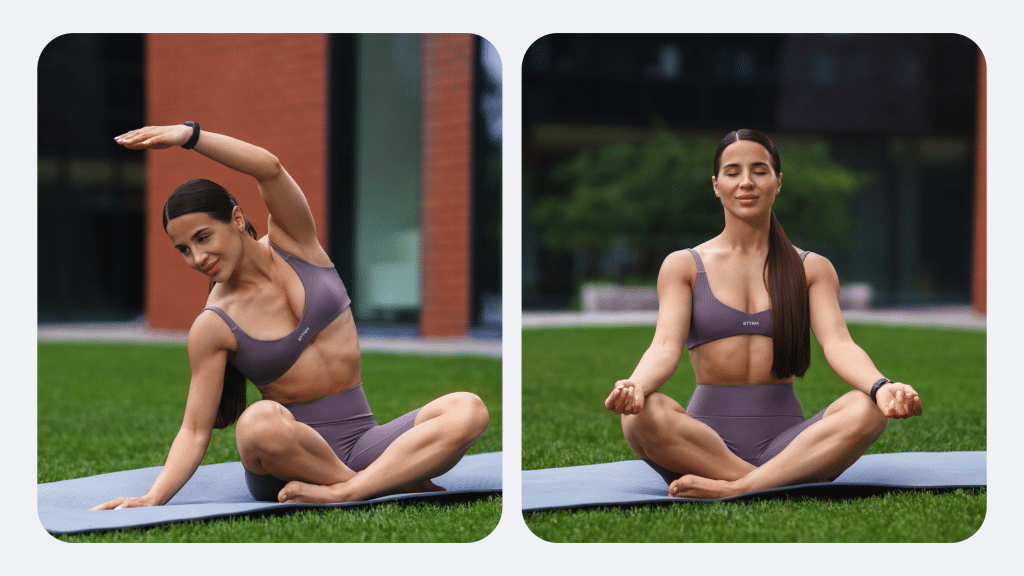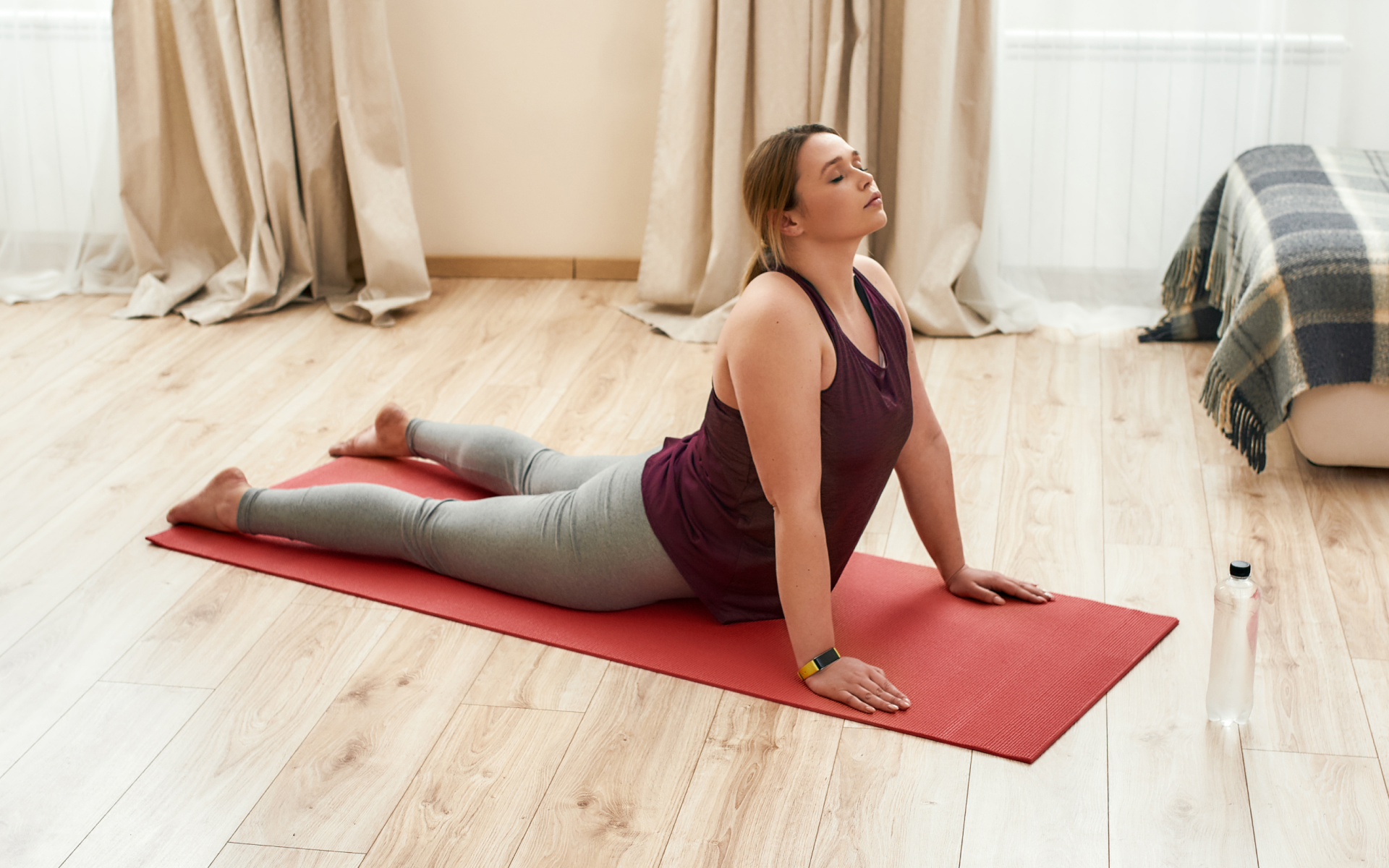During times of stress or anxiety, you may often experience a disconnect between the mind and body, as if your emotions are trapped within.
Somatic interventions help bridge that gap, helping individuals understand how emotions may present themselves physically. Through various exercises, somatic therapy aims to gradually release pent-up emotions and tension in a safe, comfortable manner. It can be highly beneficial for those who are dealing with trauma, stress, anxiety, or other emotional difficulties, – but it’s essential to seek guidance from a qualified mental health professional before you start on your own.
In this article, we’ll explore the effectiveness of somatic therapy and the most effective somatic interventions for improving the mind-body connection.
What Are Somatic Interventions?
Somatic interventions are mind-body practices that focus on how emotions are stored in the body to help individuals process and heal from trauma, stress, or other emotional difficulties (1).
Somatic experiencing (SE), which was developed by Dr. Peter Levine in the 1970s, is the most common form of somatic psychology. It aims to release the physiological effects of stress, trauma, and anxiety by gently guiding individuals to tune into bodily sensations, allowing them to safely process difficult emotions without becoming overwhelmed (2).
Other common types of somatic therapy psychology include:
- Sensorimotor Psychotherapy: Combines talk therapy with body-centered techniques, focusing on the interplay between emotions, thoughts, and physical sensations to help process trauma and build healthier patterns of behavior (3).
- Hakomi Method: Integrates principles from sensorimotor psychotherapy and present-moment mindfulness to explore core beliefs and unconscious patterns of behavior without judgment (4).
- EMDR: A structured therapy that uses bilateral stimulation (e.g., left-right eye movements) to help individuals process and heal from traumatic memories. It’s, done under the guidance of a specialized mental health professional (5).
- Grounding: A body-based method that uses physical senses to bring you back to the present moment, reducing feelings of distress and anxiety (17).
Nearly all types of mind-body therapy use similar somatic interventions to address the mind-body connection, acknowledging how emotions are often stored in the body – sometimes without us even realizing it.
It’s important to note that choosing the right somatic therapy should always be done in consultation with a healthcare provider to ensure it is aligned with your individual health needs and goals.
Benefits of Somatic Interventions
Somatic therapy interventions may be beneficial for individuals who have experienced trauma, anxiety, chronic stress, emotional dysregulation, or other challenges. They may also be valuable for anyone who is looking to enhance their emotional well-being by developing better coping skills that calm the nervous system during stressful times.
When engaging in somatic interventions regularly, common benefits may include:
- Potential reduction in stress and anxiety (2)
- Potential relief from trauma symptoms (6)
- Potential increase in body awareness (7)
- Potential improvement in emotional regulation skills (2)
- Potential relief from chronic pain or tension (8)
What Is an Example of Somatic Intervention?
One of the most accessible, yet still highly effective, somatic intervention examples is breathwork – particularly diaphragmatic breathing, which facilitates a complete oxygen exchange, effectively calming the nervous system (9).
By focusing on slow, deep breaths, diaphragmatic breathing activates the body’s innate relaxation response, which reduces feelings of tension, stress, and anxiety. Fortunately, this somatic intervention can be practiced from anywhere, whether you’re at home, at work, or on the go, which makes it highly valuable for managing daily stress and anxiety.
Whether you’re a workout beast or just a beginner making your first foray into the world of fitness and dieting – BetterMe has a lot to offer to both newbies and experts! Install the app and experience the versatility first-hand!
What Is the Most Effective Somatic Technique?
Importantly, the effectiveness of somatic techniques can vary widely based on a person’s individual circumstances, health needs, and goals. While one person may benefit from movement-based techniques such as yoga, others may prefer relaxation strategies such as deep breathing and meditation.
Experimenting with different somatic therapy exercises can help you determine which works best for you. It’s advisable to do this underwith the guidance of a mental health professional, as they can offer personalized guidance and support to ensure a safe and effective healing journey.
If you’re unsure where to start, the BetterMe app offers plenty of resources and tutorials on somatic exercises to guide you along the way!
Read more: Somatic Meditation: Definition, Benefits, and How To
5 Most Effective Somatic Interventions Explained
Regardless of the type of somatic therapy, many approaches share core principles and interventions, laying the groundwork to address how emotions are stored in the body. Here’s a breakdown of five of the leading effective somatic interventions:
- Body Awareness
When first engaging in somatic therapy, the common first step is to start to develop body awareness, tuning into any physical sensations, emotions, and movements in the body without judgment (10).
This practice encourages individuals to pay closer attention to how their bodies hold on to certain emotions while building a deeper understanding of the mind-body connection. With this awareness, you may better notice and identify areas of tension and discomfort, allowing you to release them in a healthy way.
Common somatic exercises used to develop and improve body awareness include:
- Body scan meditation: Lying or sitting comfortably, individuals systematically focus their attention on different body parts, noticing any sensations or tension without judgment or trying to change them (11).
- Progressive muscle relaxation: Involves gradually tensing and then relaxing various muscle groups in the body to build awareness of areas of tension and relaxation (12).
- Mindful movement: Engaging in slow, intentional movements (e.g. , gentle yoga, tai chi, controlled stretching), allowing individuals to increase awareness of how they feel during movement (13).
- Resourcing
An essential part of any trauma-centered therapy, resourcing focuses on identifying positive experiences, memories, feelings, and other resources that provide a sense of safety and support during challenging or stressful times (14, 21).
Essentially individuals develop a mental “resource bank” that they can draw upon when facing stress or anxiety. By gathering these resources, individuals may better anchor themselves into their safe space, which makes it easier to navigate difficult emotions and experiences with greater emotional resilience.
Common resources used in somatic therapy include:
- Positive memories: Recalling moments of joy, comfort, or achievement
- Safe places: Imagining a calm, secure environment, – whether real or imaginary
- Supportive figures: Connecting with trusted friends, family, and mentors
- Positive affirmations: Repeating positive messages or mantras to oneself
- Titration and Pendulation
One main goal of somatic therapy is to avoid overwhelming clients by addressing trauma symptoms or challenging emotions directly. Instead, they gradually unravel these emotions and memories in a slow, healthy manner. Two key somatic interventions that illustrate this approach are titration and pendulation (14, 22).
- Titration: Involves breaking down stressful experiences into smaller, more manageable pieces, allowing clients to address emotions gradually, and pausing to notice any physical sensations.
- Pendulation: Involves moving back and forth between distressing emotions and more positive, calming emotional states, helping clients build better resilience and emotional regulation skills.
This gradual approach to healing can be particularly beneficial for those who are dealing with significant trauma, as it minimizes the risk of causing retraumatization (15). By allowing individuals to process emotions and experiences in small parts, titration and pendulation may be highly effective somatic interventions for trauma healing.
Reasons why BetterMe is a safe bet: a wide range of calorie-blasting workouts, finger-licking recipes, 24/7 support, challenges that’ll keep you on your best game, and that just scratches the surface! Start using our app and watch the magic happen.
- Boundary Setting
In the context of somatic therapy, setting boundaries involves taking time to understand your emotional and physical needs while learning to feel safe and secure amidst stressful or traumatic emotions (16). This is particularly important for individuals with interpersonal trauma who may need help setting appropriate, healthy boundaries (23).
It’s important to note that establishing healthy boundaries involves respecting your own needs while remaining mindful of others. Remember boundaries can change depending on particular circumstances and life changes, so be open to reassessing your emotional boundaries as necessary.
Healthy boundaries are essential in all somatic therapies and exercises, allowing you to recognize your own needs while feeling safe and in control of your healing journey. They can also help prevent adding future unnecessary tension and stress to your plate.
- Grounding and Mindfulness
Grounding and mindfulness are powerful somatic interventions that focus on turning youro attention back to the present moment, which allows you to better connect with your surroundings and bodily sensations.
For those who are managing chronic stress and anxiety, grounding may be particularly effective for providing immediate relief. By noticing physical sensations and surroundings, this practice can redirect your attention away from distressing thoughts, helping you regain a sense of emotional balance (17).
Similarly, mindfulness emphasizes present-moment awareness but is also focused on the non-judgmental observation of thoughts and emotions (18). It encourages individuals to acknowledge their emotions as they arise without suppressing or trying to change them, which allows for a more compassionate understanding of one’s internal experiences.
Read more: 28-Day Somatic Yoga Challenge: Transform Your Mind-Body Connection
How Can I Do Somatic Therapy by Myself?
Before embarking on any form of somatic therapy, it’s always important to consult a healthcare professional to ensure it is aligned with your individual health needs and goals. This is particularly true for those who are dealing with PTSD, trauma symptoms, or other mental health conditions.
The process of unlocking stored emotions can often bring unwanted experiences or memories to the table. When this happens, having a mental health professional to guide you through the process can help you resolve these feelings safely and effectively.
Once you’ve received the go-ahead from your healthcare provider, some of the best forms of somatic therapy you can practice on your own include body scanning, progressive muscle relaxation, breathing exercises, and mindfulness techniques.
Furthermore, when engaging in somatic interventions, creating a suitable environment is the key to getting the most out of your practice. Here are some tips to help you create a safe and comfortable space to practice somatic exercises:
- Choose a quiet, comfortable area that is free from distractions
- Turn off phone notifications and consider using calming music or nature sounds
- Use cushions, pillows, or mats as needed for comfort and physical support
- Consider having a trusted person nearby who canto provide support or reassurance
Although current research is limited, somatic exercises have shown promising results for many individuals who are dealing with chronic stress, anxiety, and other difficult emotions. By understanding how emotions are stored in the body, these exercises may help release stored emotions, reduce stress, and improve emotional regulation abilities (2). Yes, eye movement desensitization and reprocessing (EMDR) can be considered a somatic intervention, as it addresses how traumatic memories are stored in the body (5). Typically, EMDR focuses on bilateral stimulation, such as left-right eye movements, to help individuals associate emotions with particular physical sensations. Depending on the way it’s practiced, Pilates may be considered a somatic exercise. When focused on body awareness and mindful breathwork, rather than outcomes or appearance-related goals, Pilates can be effective for improving emotional regulation skills while potentially reducing feelings of stress and anxiety (19). Yes, walking can be considered a somatic exercise, as it encourages awareness of bodily sensations and promotes a connection to the present moment. As you walk, you can tune into your breath, the movement of your body, and the environment around you, which makes it a simple yet effective way to potentially reduce stress and tension (20).Frequently Asked Questions
Do somatic exercises really work?
Is EMDR a somatic intervention?
Is Pilates a somatic practice?
Is walking a somatic exercise?
The Bottom Line
When used appropriately, somatic interventions can be effective for reconnecting with the body and understanding how negative emotions may have built up over time. Remember to always consult with a healthcare provider before starting, and don’t be afraid to experiment with different exercises to find what feels most comfortable for you.
If you’re struggling to find effective somatic practices for you, the BetterMe app provides a great dealtons of valuable resources and tutorials to help you get started.!
DISCLAIMER:
This article is intended for general informational purposes only and does not serve to address individual circumstances. It is not a substitute for professional advice or help and should not be relied on for making any kind of decision-making. Any action taken as a direct or indirect result of the information in this article is entirely at your own risk and is your sole responsibility.
BetterMe, its content staff, and its medical advisors accept no responsibility for inaccuracies, errors, misstatements, inconsistencies, or omissions and specifically disclaim any liability, loss or risk, personal, professional or otherwise, which may be incurred as a consequence, directly or indirectly, of the use and/or application of any content.
You should always seek the advice of your physician or other qualified health provider with any questions you may have regarding a medical condition or your specific situation. Never disregard professional medical advice or delay seeking it because of BetterMe content. If you suspect or think you may have a medical emergency, call your doctor.
SOURCES:
- What is somatic therapy? (2023, health.harvard.edu)
- Somatic experiencing – effectiveness and key factors of a body-oriented trauma therapy: a scoping literature review (2021, nih.gov)
- Sensorimotor psychotherapy in the treatment of trauma (2019, APA PsycNet)
- The Hakomi Method: Defining Its Place Within the Humanistic Psychology Tradition (2011, journals.sagepub)
- A FLASH OF HOPE: Eye Movement Desensitization and Reprocessing (EMDR) Therapy (2020, nih.gov)
- Somatic Experiencing for Posttraumatic Stress Disorder: A Randomized Controlled Outcome Study (2017, nih.gov)
- Somatic awareness in the clinical care of patients with body distress symptoms (2008, nih.gov)
- Moving With Pain: What Principles From Somatic Practices Can Offer to People Living With Chronic Pain (2020, nih.gov)
- Effects of Diaphragmatic Breathing on Health: A Narrative Review (2020, nih.gov)
- Body Awareness: a phenomenological inquiry into the common ground of mind-body therapies (2011, nih.gov)
- The effects of body scan meditation: A systematic review and meta-analysis (2022, nih.gov)
- Effectiveness of Progressive Muscle Relaxation, Deep Breathing, and Guided Imagery in Promoting Psychological and Physiological States of Relaxation (2021, nih.gov)
- Mindful movement and skilled attention (2015, nih.gov)
- Somatic psychotherapy tools: resourcing, titration and pendulation (2022, innercamp.com)
- Trauma-informed care: recognizing and resisting re-traumatization in health care (2021, nih.gov)
- How To Set Healthy Boundaries in Relationships (2022, Cleveland Clinic)
- Grounding the Connection Between Psyche and Soma: Creating a Reliable Observation Tool for Grounding Assessment in an Adult Population (2021, nih.gov)
- Mindfulness and Behavior Change (2020, nih.gov)
- Pilates, Mindfulness, and Somatic Education (2014, nih.gov)
- Effectiveness of a mindful nature walking intervention on sleep quality and mood in university students during Covid-19: A randomised control study (2022, nih.gov)
- Resource-Based Psychotherapy Model Application in the Treatment of Psychological Trauma Consequences (2024, nih.gov)
- Somatic experiencing: using interoception and proprioception as core elements of trauma therapy (2015, nih.gov)
- When Nowhere Is Safe: Interpersonal Trauma and Attachment Adversity as Antecedents of Posttraumatic Stress Disorder and Developmental Trauma Disorder (2018, nih.gov)










